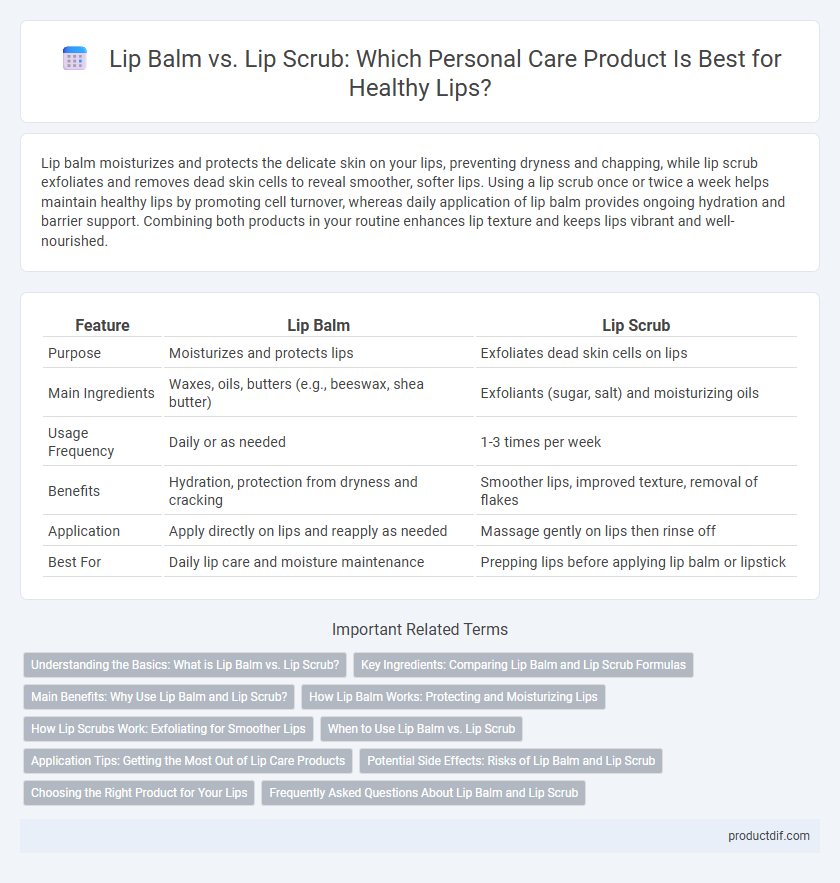Lip balm moisturizes and protects the delicate skin on your lips, preventing dryness and chapping, while lip scrub exfoliates and removes dead skin cells to reveal smoother, softer lips. Using a lip scrub once or twice a week helps maintain healthy lips by promoting cell turnover, whereas daily application of lip balm provides ongoing hydration and barrier support. Combining both products in your routine enhances lip texture and keeps lips vibrant and well-nourished.
Table of Comparison
| Feature | Lip Balm | Lip Scrub |
|---|---|---|
| Purpose | Moisturizes and protects lips | Exfoliates dead skin cells on lips |
| Main Ingredients | Waxes, oils, butters (e.g., beeswax, shea butter) | Exfoliants (sugar, salt) and moisturizing oils |
| Usage Frequency | Daily or as needed | 1-3 times per week |
| Benefits | Hydration, protection from dryness and cracking | Smoother lips, improved texture, removal of flakes |
| Application | Apply directly on lips and reapply as needed | Massage gently on lips then rinse off |
| Best For | Daily lip care and moisture maintenance | Prepping lips before applying lip balm or lipstick |
Understanding the Basics: What is Lip Balm vs. Lip Scrub?
Lip balm is a moisturizing product designed to protect and hydrate the lips, preventing dryness and chapping, often containing ingredients like beeswax, shea butter, and vitamin E. Lip scrub is an exfoliating treatment made with abrasive beads or natural exfoliants such as sugar or salt, aimed at removing dead skin cells to reveal smoother lips. Understanding these basics helps in choosing the right product: lip balm for daily hydration and protection, lip scrub for occasional exfoliation to maintain lip softness.
Key Ingredients: Comparing Lip Balm and Lip Scrub Formulas
Lip balm formulas primarily contain moisturizing key ingredients such as beeswax, shea butter, and vitamin E to provide hydration and protect lips from dryness. Lip scrubs incorporate exfoliating agents like sugar granules or crushed nuts combined with nourishing oils like coconut or jojoba oil to gently remove dead skin while maintaining lip softness. Understanding these distinctive ingredients helps in choosing the right product for either preventing chapped lips or achieving smoother texture.
Main Benefits: Why Use Lip Balm and Lip Scrub?
Lip balm provides essential hydration and protection, preventing lips from becoming dry and chapped by locking in moisture throughout the day. Lip scrub exfoliates dead skin cells, promoting smooth, soft lips and enhancing the effectiveness of lip balm absorption. Using both products in combination ensures well-nourished, healthy lips with improved texture and long-lasting softness.
How Lip Balm Works: Protecting and Moisturizing Lips
Lip balm creates a protective barrier on the lips, sealing in moisture and shielding them from environmental factors like wind, cold, and UV rays. Formulated with ingredients such as beeswax, shea butter, and natural oils, it soothes dryness and prevents chapping by maintaining hydration levels. Regular application of lip balm supports lip health by promoting softness and preventing the lips from becoming cracked or irritated.
How Lip Scrubs Work: Exfoliating for Smoother Lips
Lip scrubs work by gently exfoliating the lips using fine abrasive particles like sugar or natural seeds, which remove dead skin cells and promote cell renewal. This process enhances lip texture, leaving them smoother and better prepared for lip balm application. Regular exfoliation with lip scrubs improves moisture absorption and helps maintain soft, healthy lips.
When to Use Lip Balm vs. Lip Scrub
Lip balm is essential for daily hydration and protection of dry or chapped lips, especially in harsh weather conditions or after sun exposure. Lip scrub should be used 1-2 times weekly to exfoliate dead skin cells, promoting smoother and healthier lips without over-exfoliation. Using lip balm immediately after a lip scrub helps lock in moisture and enhance lip repair.
Application Tips: Getting the Most Out of Lip Care Products
For optimal lip care, apply lip scrub gently in circular motions to exfoliate dead skin cells before using lip balm for deep hydration and protection. Choose a lip scrub with natural exfoliants like sugar or jojoba beads to avoid irritation, and follow with a nutrient-rich lip balm containing ingredients like shea butter or beeswax. Regular use of lip scrub once or twice a week ensures smooth lips, while daily lip balm application maintains moisture and prevents chapping.
Potential Side Effects: Risks of Lip Balm and Lip Scrub
Lip balms often contain ingredients like fragrances, preservatives, and waxes that may cause allergic reactions or clog pores, leading to lip irritation or acne around the mouth. Lip scrubs, which typically include exfoliating particles and chemicals such as sugar, salt, or acids, can cause over-exfoliation, resulting in dryness, redness, or microtears on delicate lip skin. Using either product excessively or containing harsh additives increases the risk of adverse effects, emphasizing the importance of choosing formulations with gentle, natural components.
Choosing the Right Product for Your Lips
Selecting the right lip care product depends on your lip condition and desired outcome. Lip balm provides essential hydration and protection against dryness, making it ideal for everyday use to maintain soft, smooth lips. Lip scrub exfoliates dead skin cells and promotes renewal, perfect for lips that are chapped or flaky, preparing them for better absorption of moisturizing treatments.
Frequently Asked Questions About Lip Balm and Lip Scrub
Lip balm and lip scrub serve different purposes in lip care routines; lip balm hydrates and protects the lips from dryness and cracking, while lip scrub exfoliates dead skin cells to promote smoothness and improve balm absorption. Common questions include how often to use each product--lip balm can be applied daily as needed, whereas lip scrub should be used 1-3 times per week to avoid irritation. Many users also ask if lip scrub can replace lip balm, but these products complement each other rather than serve as substitutes.
Lip Balm vs Lip Scrub Infographic

 productdif.com
productdif.com